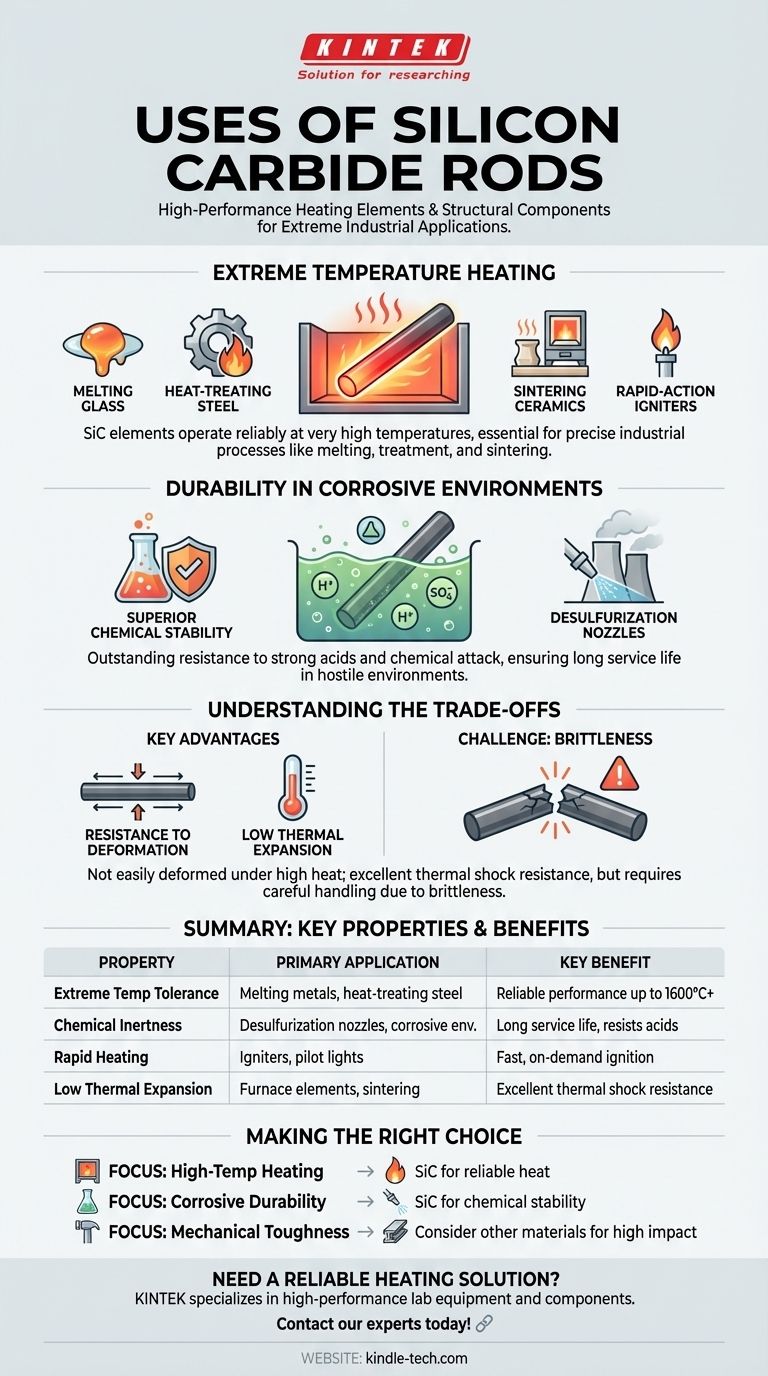In essence, silicon carbide rods are primarily used as high-performance heating elements and structural components in applications involving extreme temperatures and corrosive environments. Their unique properties make them indispensable for industrial processes like melting glass and metals, heat-treating steel, and manufacturing ceramics and electronics.
The core reason silicon carbide is chosen is its exceptional stability. It thrives in conditions of intense heat and chemical attack where most other materials would quickly fail, making it a critical material for demanding industrial heating and processing.

Why Silicon Carbide Excels as a Heating Element
Silicon carbide (SiC) is not just a structural material; its ability to generate and withstand intense heat makes it a cornerstone of modern industrial furnaces and high-temperature processes.
Extreme Temperature Tolerance
SiC elements are engineered to operate reliably at very high temperatures. This makes them essential for processes like melting non-ferrous metals and for the critical heat treatment of other metals to achieve specific hardness and durability.
Application in Glass Manufacturing
The production of float glass requires precise and uniform high temperatures. SiC rods provide the consistent and powerful heating necessary to melt the raw materials and maintain the molten glass at the correct viscosity.
Role in Ceramics and Electronics
Manufacturing advanced ceramics and electronic components often involves a process called sintering, which requires firing materials in a furnace at extreme temperatures. SiC heating elements are a standard choice for providing the necessary thermal energy.
Use as Rapid-Action Igniters
The ability of silicon carbide to heat up very quickly makes it an ideal material for igniters. These are commonly found in pilot lights for industrial gas heaters and other appliances, providing a reliable source of ignition on demand.
Unmatched Durability in Corrosive Environments
Beyond simple heat resistance, the chemical inertness of silicon carbide allows it to perform in environments that would destroy lesser materials.
Superior Chemical Stability
SiC has outstanding chemical stability, particularly its resistance to strong acids. Unlike many metals, it does not readily react with or degrade when exposed to corrosive agents, ensuring a long service life.
Application in Desulfurization
This chemical resistance is leveraged in thermal power plants and large boilers. SiC is used to make desulfurization nozzles that are constantly exposed to highly corrosive gases and liquids during the emission control process.
Understanding the Trade-offs
While powerful, silicon carbide is a specialized material with distinct physical properties that dictate its use. Understanding its limitations is key to successful application.
The Challenge of Brittleness
Silicon carbide is extremely hard, which contributes to its durability, but it is also brittle. This means it can fracture under sharp impact or excessive mechanical stress, requiring careful handling and installation.
Resistance to Deformation
A key advantage is that SiC rods are not easily deformed, even under high heat and load. This structural integrity is vital for furnace elements that must maintain their shape over thousands of hours of operation.
Low Thermal Expansion
SiC has a very small coefficient of thermal expansion, meaning it does not expand or contract much when heated or cooled. This gives it excellent resistance to thermal shock (rapid temperature changes), preventing cracking and failure.
Making the Right Choice for Your Goal
Selecting silicon carbide is a decision based on the severity of the operating environment. It is a problem-solver for conditions that push materials to their absolute limits.
- If your primary focus is high-temperature heating in a controlled furnace: SiC rods are an industry standard for providing reliable and long-lasting heat for processes like metal treatment and ceramics firing.
- If your primary focus is durability in a corrosive, high-heat environment: The unmatched chemical stability of SiC makes it the definitive choice for components like desulfurization nozzles that must endure chemical attack.
- If your primary focus is mechanical toughness or malleability: The inherent brittleness of SiC means you should consider metallic alloys or other materials designed for high-impact or forming applications.
Ultimately, silicon carbide rods are the go-to solution when you require unwavering performance in the face of extreme industrial heat and chemical hostility.
Summary Table:
| Key Property | Primary Application | Key Benefit |
|---|---|---|
| Extreme Temperature Tolerance | Melting metals, heat-treating steel | Reliable performance up to 1600°C+ |
| Chemical Inertness | Desulfurization nozzles, corrosive environments | Long service life, resists acids |
| Rapid Heating | Igniters, pilot lights | Fast, on-demand ignition |
| Low Thermal Expansion | Furnace elements, sintering | Excellent thermal shock resistance |
Need a reliable heating solution for your most demanding lab or industrial processes?
KINTEK specializes in high-performance lab equipment, including furnaces and components built with durable materials like silicon carbide. Whether you're melting glass, sintering ceramics, or working in corrosive environments, our expertise ensures you get the right equipment for precise temperature control and long-term reliability.
Contact our experts today to discuss how we can support your laboratory's high-temperature and corrosive application needs!
Visual Guide

Related Products
- Silicon Carbide SiC Thermal Heating Elements for Electric Furnace
- Molybdenum Disilicide (MoSi2) Thermal Elements Electric Furnace Heating Element
- Double Plate Heating Press Mold for Lab
- Silicon Carbide (SIC) Ceramic Sheet Wear-Resistant Engineering Advanced Fine Ceramics
- Infrared Heating Quantitative Flat Plate Press Mold
People Also Ask
- Which high temperature furnace elements to be used in oxidizing atmosphere? MoSi2 or SiC for Superior Performance
- What is SiC elements? The Ultimate High-Temperature Heating Solution
- What is silicon carbide rod heated to high temperature used as? A Premier Heating Element for Extreme Environments
- What is SiC melting point? Discover the Extreme Thermal Stability of Silicon Carbide
- What is a silicon carbide heating element? Unlock Extreme Heat for Industrial Processes



















